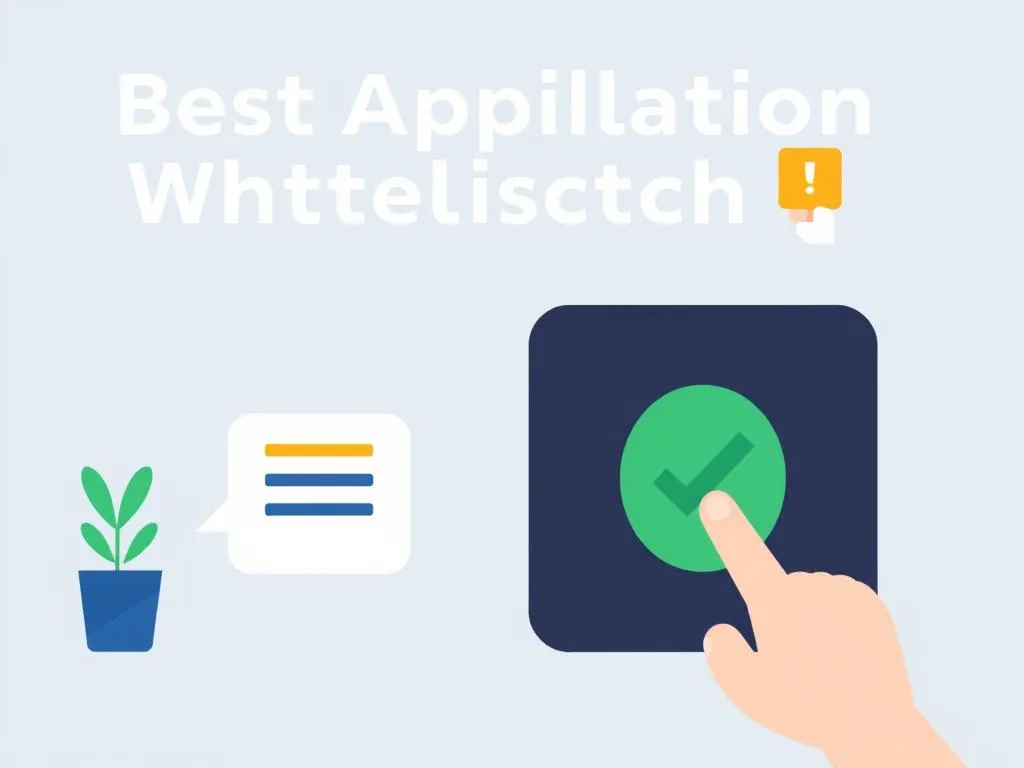Discover the best application whitelisting software, tools, and solutions for 2025. Enhance your cybersecurity with top tools like ThreatLocker and ManageEngine, designed to block unauthorized applications and reduce threats. Explore benefits, challenges, and implementation tips in this comprehensive guide.
Best Application Whitelisting Software, Tools, and Solutions for 2025: A Comprehensive Guide
In an era where cyber threats like ransomware and zero-day attacks are increasingly sophisticated, traditional antivirus solutions alone are often insufficient to protect organizational networks. Application whitelisting, also known as application allowlisting, has emerged as a proactive cybersecurity strategy that permits only pre-approved applications to execute on a system, effectively blocking all unauthorized or malicious software.
This approach, rooted in the zero-trust security model, significantly reduces the attack surface by denying execution to any unverified program. As businesses seek robust solutions to safeguard their endpoints, application whitelisting software, tools, and solutions have become essential components of modern cybersecurity frameworks.
This comprehensive guide explores the concept of application whitelisting, its importance, benefits, challenges, and the best tools available in 2025. By examining top solutions like ThreatLocker, ManageEngine Application Control Plus, AppLocker, Airlock Digital, and PC Matic, we aim to provide actionable insights for businesses and IT professionals looking to enhance their security posture. Whether you’re a small business owner or an enterprise IT administrator, this guide will help you navigate the landscape of application whitelisting to choose the right solution for your needs.
Understanding Application Whitelisting
Definition and Core Concept
Application whitelisting is a cybersecurity practice that involves creating a list of approved software applications or executable files permitted to run on a computer or network. Any application not included on this whitelist is automatically blocked, regardless of its nature—malicious or benign. This deny-by-default approach contrasts with blacklisting, which only blocks known malicious applications, allowing all others to run. Whitelisting is particularly effective in high-risk environments, such as financial institutions or healthcare organizations, where unauthorized software poses significant threats (TechTarget).
The National Institute of Standards and Technology (NIST) recommends application whitelisting for centrally managed systems, noting its ability to enhance security by limiting the execution of unapproved programs (NIST Guide). Whitelisting can apply to entire applications, specific components (e.g., plugins, libraries), or even file paths, offering granular control over system operations.
How It Differs from Black-listing
- Whitelisting: Permits only pre-approved applications, blocking everything else. It’s proactive, focusing on trusted software.
- Black–listing: Blocks known malicious applications, allowing all others. It’s reactive, relying on identifying threats, which can miss new or unknown malware.
Whitelisting’s strength lies in its ability to prevent zero-day attacks and unknown malware, as it doesn’t depend on threat signatures. However, it requires careful management to avoid blocking legitimate applications, making the choice of whitelisting software critical.
Importance in Cybersecurity
The rise of sophisticated cyber threats, including ransomware and advanced persistent threats (APTs), has exposed the limitations of traditional security measures. In 2018 alone, over 16,517 application-related security issues were reported, highlighting the need for robust defenses (ManageEngine). Application whitelisting addresses these challenges by:
- Preventing Malware Execution: Blocks unauthorized applications, reducing the risk of infections.
- Enhancing Compliance: Ensures only approved software runs, aiding adherence to regulations like HIPAA or PCI DSS.
- Improving System Stability: Limits resource-intensive or conflicting applications, enhancing performance.
For organizations, whitelisting is a cornerstone of a zero-trust security model, which assumes no application is trustworthy until verified (CrowdStrike).
Benefits of Application Whitelisting
Implementing application whitelisting offers several advantages, making it a valuable addition to any cybersecurity strategy:
- Proactive Threat Prevention: By only allowing trusted applications, whitelisting prevents unknown malware and zero-day attacks, which traditional antivirus solutions may miss.
- Reduced Attack Surface: Limiting executable applications minimizes vulnerabilities, making it harder for attackers to exploit systems.
- Regulatory Compliance: Whitelisting helps meet stringent data protection requirements by ensuring only authorized software accesses sensitive systems.
- System Efficiency: Controlling software usage reduces resource demands, preventing crashes or slowdowns caused by unapproved applications.
- Granular Control: Administrators can define precise policies, such as allowing specific versions or components, enhancing security without sacrificing functionality.
These benefits are particularly pronounced in environments with consistent workloads, such as corporate networks or industrial control systems, where NIST recommends whitelisting for its effectiveness (NIST Guide).
Challenges of Application Whitelisting
While powerful, application whitelisting is not without challenges, which organizations must address to ensure successful implementation:
- Initial Setup Complexity: Creating a comprehensive white-list requires auditing all necessary applications, which can be time-consuming, especially in dynamic environments with frequent software updates (CSO Online).
- Maintenance Overhead: Regular updates to the white-list are needed to accommodate new software versions or patches, adding administrative burden.
- Risk of Blocking Legitimate Applications: Overly restrictive policies may prevent users from running necessary programs, impacting productivity and user experience.
- User Resistance: Employees may find whitelisting restrictive, particularly if they need to request approval for new applications, leading to potential frustration (ColorTokens).
- Compatibility Issues: Some whitelisting solutions may not support all operating systems or integrate seamlessly with existing security tools, requiring careful selection.
To mitigate these challenges, organizations can leverage automated whitelisting tools with pre-existing policy templates, machine learning for dynamic updates, and user-friendly interfaces to streamline administration (Perception Point).
Top Application Whitelisting Tools for 2025
Selecting the right application whitelisting software is crucial for balancing security, usability, and manageability. Based on recent industry analyses and user feedback, the following five tools stand out as some of the best solutions available in 2025, each offering unique features to meet diverse organizational needs.
1. ThreatLocker
Description: ThreatLocker is a leading application whitelisting solution that adopts a zero-trust, deny-by-default approach to cybersecurity. It allows administrators to control which applications, scripts, and libraries can run, effectively blocking unauthorized software and preventing cyber threats like ransomware (ThreatLocker).
Key Features:
- Default deny policy with automated learning mode to catalog applications.
- Ringfencing to restrict application interactions, enhancing security.
- Cloud-based management for centralized control across endpoints.
- Granular audit logs tracking application execution details.
- 24/7 U.S.-based support with 30-second approval for new applications.
Pros:
- High user satisfaction, with a 4.6/5 rating on PeerSpot based on 37 reviews (PeerSpot).
- Easy transition to zero-trust architecture with discovery service.
- Comprehensive protection against malware and unauthorized software.
- Frequently updated global white-list reduces administrative burden.
Cons:
- Initial policy tuning may require time to avoid blocking legitimate applications.
- Cloud-based model may not suit organizations requiring on-premises solutions.
- Pricing details require direct inquiry, which may delay budgeting decisions.
Best For: Small to midsize businesses seeking robust, user-friendly whitelisting with strong support and compliance features.
2. ManageEngine Application Control Plus
Description: ManageEngine Application Control Plus is an endpoint security solution that combines application whitelisting with privilege management. It offers centralized controls and autodiscovery to streamline white-list creation and enforcement across Windows and macOS systems (ManageEngine).
Key Features:
- Autodiscovery of installed applications for quick white-list setup.
- Centralized management console for policy creation and enforcement.
- Support for Windows and macOS, with a free edition for up to 25 endpoints.
- Integration with other ManageEngine security tools for a unified approach.
- Flexible access controls per application or user group.
Pros:
- User-friendly interface simplifies policy management.
- Free edition makes it accessible for small businesses.
- Strong integration capabilities with existing IT infrastructure.
- Regular updates ensure compatibility with new software versions.
Cons:
- May include more features than needed for basic whitelisting tasks.
- Requires configuration to optimize performance in complex environments.
- Limited to Windows and macOS, excluding Linux support.
Best For: Organizations with diverse endpoint environments needing a scalable, integrated whitelisting solution.
3. AppLocker
Description: AppLocker is a built-in application whitelisting feature included in Windows 10/11 Enterprise and Education editions, as well as Windows Server 2016/2019/2022. It allows administrators to create rules to control which applications and scripts can run, leveraging Group Policy for centralized management (Microsoft AppLocker).
Key Features:
- Rule-based whitelisting for executables, scripts, Windows Installer files, and DLLs.
- Integration with Group Policy for enterprise-wide policy enforcement.
- Support for customizable rules based on file paths, publishers, or hashes.
- No additional cost for supported Windows editions.
Pros:
- Free with supported Windows versions, reducing costs.
- Easy to implement in Windows-centric environments.
- Seamless integration with existing Windows infrastructure.
- Suitable for basic whitelisting needs without third-party software.
Cons:
- Can be bypassed programmatically, reducing effectiveness against advanced threats.
- Limited to Windows operating systems, excluding macOS and Linux.
- Lacks advanced features like automated discovery or cloud management found in third-party tools.
Best For: Small businesses or organizations with Windows-only environments seeking a cost-effective, basic whitelisting solution.
4. Airlock Digital
Description: Airlock Digital provides a deny-by-default application whitelisting solution that enforces strict security policies across Windows, macOS, and Linux endpoints. It is designed to protect against unauthorized applications and ensure compliance with standards like HIPAA and PCI DSS (Airlock Digital).
Key Features:
- Networked controls for centralized policy management.
- Blocks intruder probes and supports emergency bypass for critical situations.
- Compliance reporting for regulatory standards.
- Detailed logging of application execution and file access.
- Cross-platform support for Windows, macOS, and Linux.
Pros:
- Broad OS compatibility enhances flexibility.
- Strong compliance features for regulated industries.
- Comprehensive logging and reporting capabilities.
- User-friendly interface for policy management.
Cons:
- Setup can be time-intensive for large networks.
- Pricing information not publicly available, requiring direct inquiry.
- May lack some advanced automation features compared to competitors.
Best For: Organizations with multi-OS environments or strict compliance requirements needing a reliable whitelisting solution.
5. PC Matic
Description: PC Matic is a cybersecurity solution that emphasizes application whitelisting to prevent malware and ransomware. It uses a global white-list maintained by its malware research team, reducing the need for manual updates and offering real-time protection (PC Matic).
Key Features:
- Global white-list updated by PC Matic’s research team.
- Automated testing and categorization of new applications.
- Simple management dashboard for IT administrators.
- Real-time protection against zero-day attacks.
- Support for Windows operating systems.
Pros:
- Easy to use with minimal configuration required.
- Affordable pricing, starting at $50 per year for individual users.
- Effective at preventing malware and ransomware through a deny-by-default approach.
- Reduces administrative burden with automated white-list updates.
Cons:
- Limited to Windows, excluding macOS and Linux support.
- May lack advanced features like ringfencing or cross-platform management.
- Less suited for large enterprises with complex needs.
Best For: Small businesses or individual users seeking an affordable, user-friendly whitelisting solution for Windows environments.
Choosing the Right Application Whitelisting Software
Selecting the best application whitelisting software depends on your organization’s specific needs, budget, and technical capabilities. Here are key factors to consider:
- Operating System Support: Ensure the tool supports your environment (e.g., Windows, macOS, Linux). Airlock Digital is ideal for multi-OS setups, while AppLocker and PC Matic are Windows-focused.
- Ease of Use: Look for user-friendly interfaces and automation features to reduce setup and maintenance time. ThreatLocker and ManageEngine excel in this area.
- Compliance Requirements: If you operate in a regulated industry, choose a tool with robust reporting, like Airlock Digital or ThreatLocker.
- Scalability: Consider whether the solution can handle your current and future endpoint volumes. ManageEngine and ThreatLocker are highly scalable.
- Integration: Check compatibility with existing security tools or IT infrastructure. ManageEngine integrates well with other ManageEngine products.
- Cost: Evaluate pricing against features. AppLocker is free for Windows users, while PC Matic offers affordable plans, but premium tools like ThreatLocker may require a higher investment.
- Support and Updates: Opt for solutions with reliable support and regular updates to address new threats. ThreatLocker’s 24/7 support is a standout feature.
To make an informed decision, request demos or trials from providers like ThreatLocker or ManageEngine, and test their performance in your environment. For Windows users, experimenting with AppLocker’s built-in features can be a low-risk starting point.
Implementation Best Practices
To maximize the effectiveness of application whitelisting, follow these best practices:
- Audit Your Environment: Start by scanning your network to identify all installed applications and establish a baseline of necessary software (Heimdal Security).
- Use Learning Mode: Many tools, like ThreatLocker, offer a learning mode to catalog applications automatically, simplifying initial whitelist creation.
- Regularly Update Whitelists: Review and update your whitelist to include new software versions or remove obsolete applications, reducing vulnerabilities (Perception Point).
- Test Policies: Deploy policies in a test environment to avoid blocking critical applications, ensuring minimal disruption to users.
- Leverage Automation: Use tools with automated discovery and update features, like PC Matic’s global whitelist, to reduce administrative overhead.
- Educate Users: Inform employees about whitelisting policies to manage expectations and reduce resistance to restrictions.
- Monitor and Audit: Continuously monitor logs and audit whitelists to detect anomalies or policy violations, enhancing security (CSO Online).
Future Trends in Application Whitelisting
As cyber threats evolve, application whitelisting solutions are adapting to meet new challenges. In 2025, key trends include:
- Machine Learning Integration: Tools like ThreatLocker are incorporating machine learning to dynamically update whitelists based on usage patterns, reducing manual effort (Perception Point).
- Zero-Trust Adoption: Whitelisting is becoming a core component of zero-trust architectures, with solutions like ThreatLocker leading the way (CrowdStrike).
- Cross-Platform Expansion: More tools are supporting macOS and Linux alongside Windows, as seen with Airlock Digital, to address diverse IT environments.
- Compliance Automation: Enhanced reporting features are helping organizations meet regulatory requirements more efficiently, particularly in healthcare and finance (Airlock Digital).
These trends suggest that application whitelisting will continue to play a pivotal role in cybersecurity, offering proactive protection in an increasingly complex threat landscape.
Conclusion
Application whitelisting is a powerful cybersecurity strategy that offers unmatched protection against unauthorized and malicious software. By carefully selecting and implementing the right whitelisting software, organizations can significantly enhance their security posture, ensure compliance, and maintain system stability. The top tools for 2025—ThreatLocker, ManageEngine Application Control Plus, AppLocker, Airlock Digital, and PC Matic—provide a range of features to meet diverse needs, from small businesses to large enterprises. By understanding their capabilities, benefits, and challenges, you can choose a solution that aligns with your organization’s goals and protects your digital assets effectively.














Leave a Reply